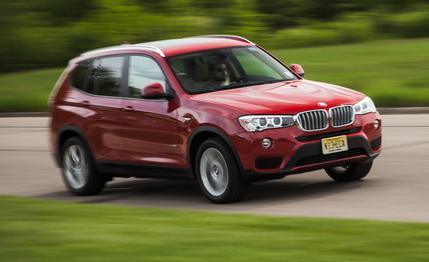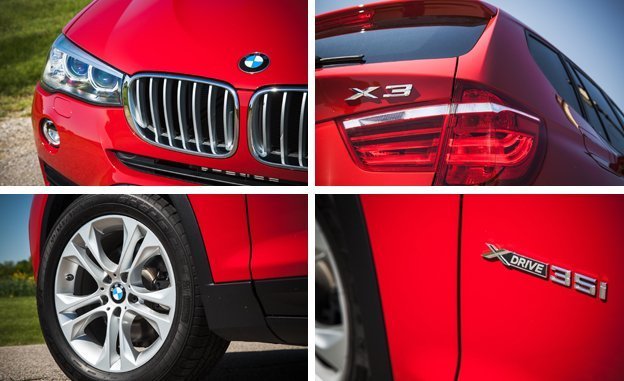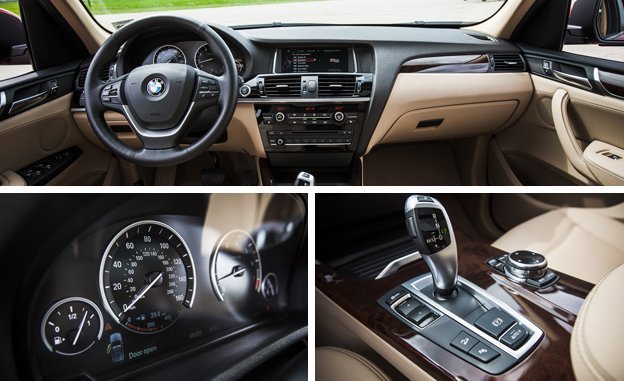
 Instrumented Test
Instrumented Test
New compact luxury crossovers are being introduced apace, with strong-selling models like the Lexus NX and the Lincoln MKC claiming large slices of a pie once carved up almost exclusively by Acura, BMW, Mercedes, and Audi. But there’s still goodness to be found among the older guard, particularly BMW’s X3.
Introduced in 2003 as one of the first of its breed, the BMW X3 entered its second generation for 2011 and was updated for 2015 with revised styling, the addition of diesel and rear-drive models, and some new convenience features. So far the only refreshed model we’ve tested was—ahem—the xDrive28d diesel, but we’ve reviewed this generation plenty. The turbocharged gasoline four-cylinder model won a comparison test against the Audi Q5 and the Range Rover Evoque, and we’ve also spent quality time with the four-cylinder xDrive28i and the pre-update xDrive35i.


What didn’t change in the update was the driving experience. The X3’s chassis—an adaptation of the 3-series’—delivers levels of engagement and poise rare among its peers. While our preferred choice for back-road bombing is something much lower to the ground, the X3 is willing to play along, and it’s well suited for day-to-day driving, too. The steering is accurate and linear (if not particularly talkative), and the chassis offers a ride-and-handling balance that belies this crossover’s height and weight, although the ride can verge on too firm with the larger wheels and sportier suspension options our review model lacked. The X3’s standout trait, however, is simply how cohesive it feels in operation; whether driven hard or at a lesser pace, its major elements all work in harmony.
BMW’s familiar, 300-hp N55 turbocharged six is as smooth and tractable here as in its myriad other applications, offering good power throughout its rev range, and it scoots the 4200-pound xDrive35i to 60 mph in a relatively strong 5.3 seconds, a 0.2-second improvement over our test of the 2011 version. All-wheel drive is standard with this engine, as is a well-programmed and unobtrusive eight-speed automatic transmission.
However, as with several other X3s we’ve tested, braking distance from 70 mph was disappointing—15 feet or so off the segment’s best. The hardware is solid, and the brake pedal offers consistent feel, but the X3 should be better. The factory-fitted all-season rubber might be to blame, but at this price point, one shouldn’t have to swap out tires to get satisfactory stopping performance.


Speaking of price, the X3 isn’t cheap. While the rear-drive sDrive28i and its turbocharged four-cylinder engine ring in around $40K, the 35i starts at $46,025 and goes up from there—our example rang in at $54,325. While the $950 Cold Weather pack (heated front and rear seats, heated steering wheel, headlamp washers) and $550 red paint seem like reasonable charges, the $3150 Technology (navigation, head-up display, BMW Apps and other connectivity functions) and $2200 Premium packages (leather, proximity entry and start, adjustable lumbar support, satellite radio) come across as gouging to us; we’d likely leave at least one of those boxes unchecked. The balance of the as-tested price can be chalked up to the $950 Driver Assistance bundle (rearview camera, parking sensors) and $500 Bluetooth and smartphone connectivity.
It turns out the old guard can still do good, and if you can’t bear the thought of driving an actual station wagon instead of a station wagon on stilts—and can deal with BMW’s uninspiring interior design—the X3 remains a fine choice in a fiercely competitive segment. Just watch it with the options.